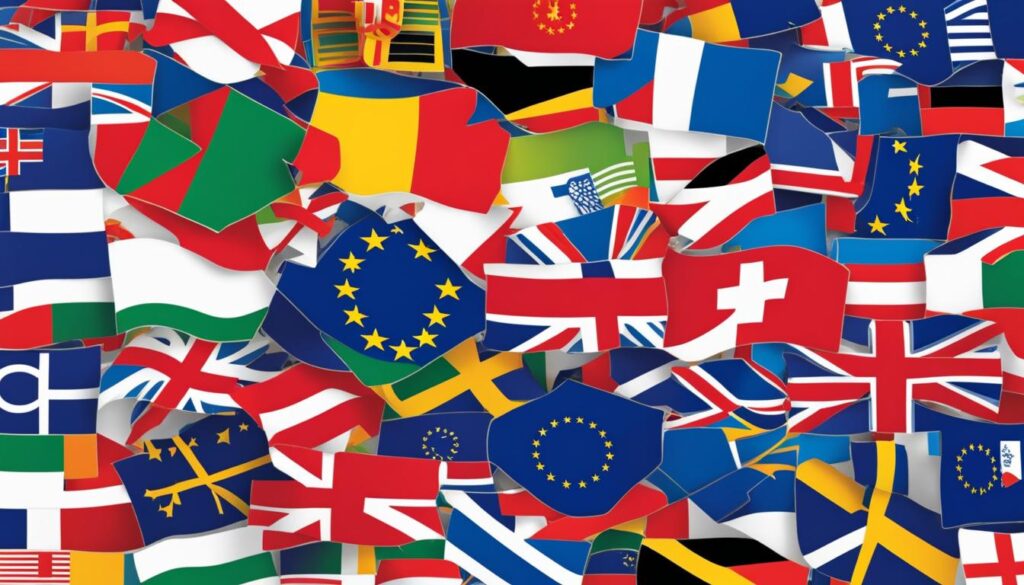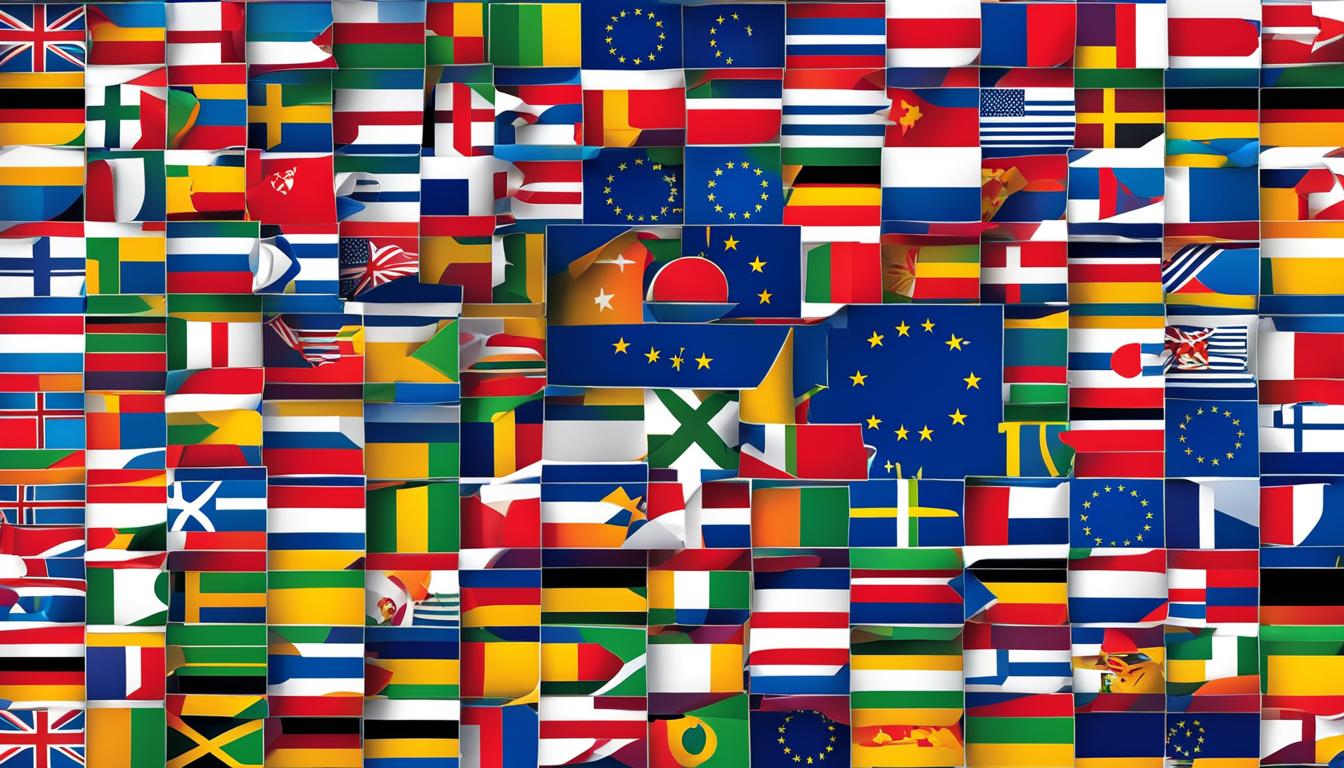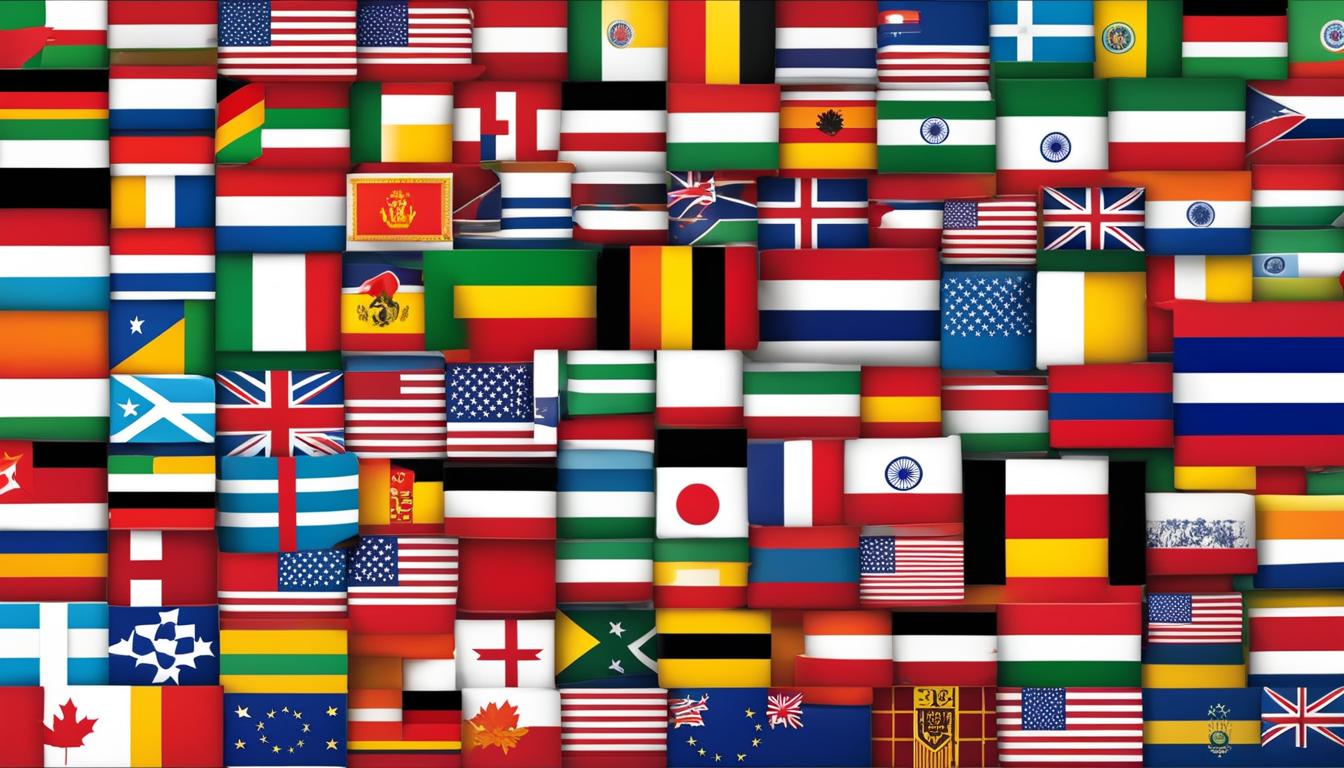The European Union (EU) and the European Economic Area (EEA) are often mentioned in discussions related to Europe’s political and economic landscape. While they are connected, it’s important to understand the differences between the two. Let’s explore the distinctions and how they impact trade, policy, and membership.
Key Takeaways:
- The European Economic Area (EEA) Agreement brings together EU member countries and three EFTA states (Iceland, Liechtenstein, and Norway) into a single market.
- EEA countries are part of the EU’s single market but have no say in the EU’s political decisions.
- The EEA Agreement focuses on the “four freedoms”: free movement of goods, services, persons, and capital throughout member states.
- While all EU members are automatically part of the EEA, not all EEA members are EU members.
- As a result of Brexit, the United Kingdom left both the EU and the EEA, impacting trade and freedom of movement.
Understanding the European Economic Area (EEA) Agreement
The European Economic Area (EEA) Agreement, established in 1992, is a comprehensive agreement that fosters economic integration between the member countries of the European Union (EU) and three European Free Trade Association (EFTA) states: Iceland, Liechtenstein, and Norway. The agreement aims to create a single market where goods, services, persons, and capital can freely move, thereby promoting trade and economic growth.
One of the key pillars of the EEA Agreement is the harmonization of regulations and standards across member states. EEA countries are required to adopt and implement EU regulations that govern the “four freedoms” throughout their territories. These freedoms include the free movement of goods, services, persons, and capital. By aligning their rules with those of the EU, EEA countries eliminate trade barriers and ensure equal conditions of competition within the single market.
While the EEA Agreement enhances economic cooperation and trade, it is important to note that it does not cover all areas of EU integration. EEA member states are exempt from certain EU policies, such as the common agriculture and fisheries policies, customs union, common trade policy, common foreign and security policy, and the European Economic and Monetary Union (EMU). However, EEA countries do participate in various other areas of cooperation, including research and development, education, social policy, and the environment.
| Key Features of the EEA Agreement |
|---|
| Establishes a single market for goods, services, persons, and capital among EEA member states and the EU |
| Requires the adoption and implementation of EU regulations governing the “four freedoms” throughout the EEA |
| Exempts EEA countries from certain EU policies, such as agriculture and fisheries, customs union, and common trade policy |
| Encompasses cooperation in areas such as research and development, education, social policy, and the environment |
The European Economic Area (EEA) Agreement plays a crucial role in facilitating trade and economic integration between the European Union (EU) and the three EFTA member states. By harmonizing regulations and ensuring the free movement of goods, services, persons, and capital, the EEA Agreement creates a single market that promotes economic growth and enhances cooperation among its member countries.
The EEA vs. the EU
While the European Economic Area (EEA) and the European Union (EU) are closely related, they are not the same. All EU members are automatically part of the EEA, but not all EEA members are EU members. The EEA agreement primarily focuses on the single market and its relevant laws, while the EU is both an economic and political union. Several EFTA members, including Austria, Finland, and Sweden, have transitioned to become EU members over the years. Switzerland is a member of EFTA but not the EEA; it has bilateral agreements with the EU instead. The EEA countries must comply with EU regulations and make financial contributions, although smaller than those of EU members.
The EEA and the EU have distinct differences in terms of political decision-making and policy areas. While EEA countries are part of the EU’s single market, they do not have a say in the EU’s political decisions. The EU has common policies in various areas such as agriculture, fisheries, customs, trade, foreign affairs, and security, which are not included in the EEA agreement. This means that EEA countries are exempt from certain EU common policies related to security, justice, home affairs, and the European Economic and Monetary Union (EMU).
To summarize, the EEA and the EU may share a single market, but they differ in terms of political integration and policy areas. The EU is a comprehensive economic and political union, while the EEA focuses solely on economic cooperation. While the EEA includes all EU member states and three non-EU EFTA countries, not all EEA members are part of the EU. Understanding these differences is crucial for comprehending the complexities of the European economic and political landscape.
Table: Comparison of the EEA and the EU
| EEA | EU | |
|---|---|---|
| Membership | Includes all EU member states and three non-EU EFTA countries (Iceland, Liechtenstein, Norway) | Includes EU member states |
| Political Decision-Making | No say in EU’s political decisions | Participates in EU’s political decision-making processes |
| Policy Areas | Focuses on the single market; exempt from certain EU policies | Includes common policies on agriculture, fisheries, customs, trade, foreign affairs, security, justice, and home affairs |
| Financial Contributions | Contributes financially to the EU, but smaller than EU members | Contributes financially to the EU |
EEA Members
The European Economic Area (EEA) consists of 30 member countries, with 27 of them being both EEA and European Union (EU) members. The remaining three EEA members are Iceland, Liechtenstein, and Norway, which are not part of the EU. However, it is important to note that the EEA includes all 27 EU member states, along with these three non-EU EEA countries.
In the context of the United Kingdom (UK), it was previously an EEA and EU member. However, as a result of Brexit, the UK left both the EU and the EEA. This departure had significant implications for the UK’s trade relations with other European countries, as well as various sectors such as agriculture and tourism.
EEA Members:
- Iceland
- Liechtenstein
- Norway
- Austria (also an EU member)
- Belgium (also an EU member)
- Bulgaria (also an EU member)
- Croatia (also an EU member)
- Cyprus (also an EU member)
- Czech Republic (also an EU member)
- Denmark (also an EU member)
- Estonia (also an EU member)
- Finland (also an EU member)
- France (also an EU member)
- Germany (also an EU member)
- Greece (also an EU member)
- Hungary (also an EU member)
- Ireland (also an EU member)
- Italy (also an EU member)
- Latvia (also an EU member)
- Lithuania (also an EU member)
- Luxembourg (also an EU member)
- Malta (also an EU member)
- Netherlands (also an EU member)
- Poland (also an EU member)
- Portugal (also an EU member)
- Romania (also an EU member)
- Slovakia (also an EU member)
- Slovenia (also an EU member)
- Spain (also an EU member)
- Sweden (also an EU member)

Brexit and the EEA
The United Kingdom’s decision to leave the European Union (EU) through Brexit also resulted in the country’s departure from the European Economic Area (EEA). As of January 31, 2020, the UK is no longer an EEA member. This significant change has had implications for various aspects, including trade and tourism.
With regards to trade, Brexit has introduced new challenges for British companies. The UK’s departure from the EEA means that trade barriers have been established between the UK and other European countries that are still part of the EEA. This has affected the movement of goods, services, and the overall flow of trade between the UK and its former EEA partners.
In the tourism sector, Brexit has also had an impact. As part of the EEA, UK citizens previously enjoyed the freedom of movement within the member states. However, with the UK no longer being an EEA member, the ease of travel for UK citizens to EEA countries has been affected. This has resulted in changes to visa requirements and potentially more complex travel arrangements.
Table: Impact of Brexit on Trade and Tourism
| Impact | Trade | Tourism |
|---|---|---|
| New Trade Barriers | Trade barriers have been established between the UK and EEA countries, impacting the movement of goods and services. | N/A |
| Changes to Travel | N/A | UK citizens may face changes to visa requirements and potentially more complex travel arrangements when visiting EEA countries. |
It is important to note that the impact of Brexit on trade and tourism is still unfolding, and further developments may occur as new agreements and arrangements are negotiated between the UK and the EU. The ultimate outcome of these negotiations will shape the future relationship between the UK and the EEA in terms of trade and tourism.
Conclusion
In conclusion, the European Union (EU) and the European Economic Area (EEA) have distinct differences and areas of overlap. While the EU is a comprehensive economic and political union, the EEA focuses solely on economic matters. The EEA includes all EU member states and three non-EU EFTA countries, but not all EEA members are part of the EU. The EEA countries participate in the EU’s single market, benefiting from the free movement of goods, services, persons, and capital, while being exempt from certain political decisions made within the EU.
It is important to note that Brexit had significant implications for the relationship between the UK and the EU, resulting in the UK’s departure from both the EU and the EEA. This change impacted trade and various sectors such as agriculture and tourism. Companies and farmers faced new trade barriers, and UK citizens’ freedom of movement within the EEA was affected.
Overall, understanding the differences and similarities between the EU and the EEA is crucial for comprehending the dynamics of European economic and political integration. While the EU represents a comprehensive union with broader political goals, the EEA focuses on fostering a single market and economic cooperation. By recognizing these distinctions, we can better understand the complexities of European integration and its impact on member states and their economies.
FAQ
What is the difference between the European Union (EU) and the European Economic Area (EEA)?
The EU is both an economic and political union, while the EEA focuses solely on economic affairs.
How many countries are part of the European Economic Area (EEA)?
There are currently 30 member countries in the EEA, including 27 EU members and three non-EU EEA countries.
Which countries are part of the EEA but not the EU?
Iceland, Liechtenstein, and Norway are EEA members that are not part of the EU.
Is the United Kingdom still a member of the EEA?
No, the UK left both the EU and the EEA as a result of Brexit.
How has Brexit affected trade between the UK and other European countries?
Brexit has resulted in new trade barriers and challenges for British companies and farmers.
What was the impact of Brexit on the freedom of movement for UK citizens within the EEA?
Brexit has impacted the freedom of movement for UK citizens within the EEA.
Did Brexit negotiations result in an alternative arrangement for the UK’s EEA membership?
No, Brexit negotiations did not result in an alternative arrangement for the UK’s EEA membership.
 Skip to main content
Skip to main content


